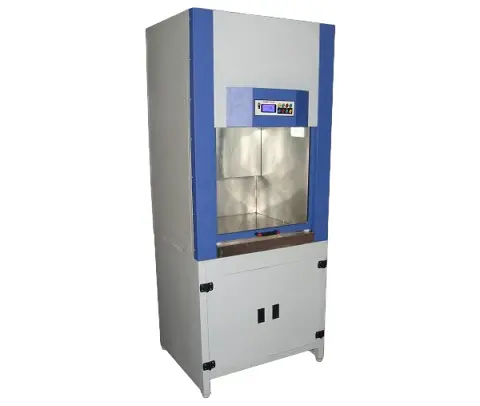Fume Hood Manufacturers
Fume Hood Manufacturers in India
Model ELI- FH
In laboratories, keeping the air clean and ensuring safety are top priorities. Fume hood chamber are essential tools for this. They trap harmful fumes and gases. This keeps lab workers safe and experiments intact. Fume hoods are like safety shields in labs. They suck in dangerous chemicals, keeping the air safe for everyone. This is crucial for lab workers’ health and the success of experiments.
As a leading fume hood supplier and manufacturer, Laboratory Testing Instruments is renowned for manufacturing top-quality fume hoods.
Laboratory Testing Instrument makes top-notch lab equipment, including fume hoods. They’re committed to making safe, reliable hoods for all kinds of labs.
Importance of Fume Hoods in Laboratories
- Protecting People– A large fume hood is like a shield for scientists against harmful chemicals. It sucks up all the bad fumes, keeping scientists safe from breathing them in.
- Keeping Experiments Clean– Imagine doing a delicate experiment. Then, a breeze blows in some dust or contaminants. That could ruin everything! Fume hoods create a clean space, free from outside interference.
- Following Rules– Labs have strict rules to follow for safety. Fume hoods help labs follow these rules. They ensure everyone stays safe and that experiments meet standards.
In short, laboratory fume hood are the unsung heroes of the lab. They keep scientists safe and experiments on track, including salt spray chambers, salt spray test chambers, and UV Light Accelerated Weathering Tester Chambers.
How Do Fume Hoods Work?
A lab fume hood operates by containing harmful substances inside, using suction to draw air and dangerous particles away from workers. This air is then either filtered and released outside or circulated back into the room.
fume hood uses in laboratories and industrial settings to protect personnel and the environment from potentially hazardous fumes, gases, or vapors.
Types of laboratory Fume Hood
Ducted Fume Hoods
Ducted fume hoods connect to the vents. They suck the air out and push it outside. They’re great for dealing with dangerous stuff.
Ductless Fume Hoods
Lab fume hood, specifically ducted ones, are connected to vents, effectively sucking air out and expelling it outside. They serve as excellent solutions for handling hazardous materials.
Portable Fume Hood chamber
These are movable and handy for short-term setups or outdoor work. They’re small and easy to move around, giving protection wherever you need it.
- Containment Fume hoods keep harmful things inside, so they don’t get out.
- Ventilation sucks out dirty air. This keeps the workspace clean to breathe. Fume hoods keep people away from dangerous chemicals.
- They also shield them from particles. This protects people from harm.
- Versatility they come in different types to fit different labs and needs.
- Fume hoods are used in laboratories to safely contain and exhaust harmful fumes and vapors generated during experiments or when working with hazardous chemicals.
- They follow rules to make sure labs stay safe and legal.
- Easy controls and comfy designs make them simple for lab folks to use.
- You can change some customization to fit special experiments or lab layouts.
A four-inch fan blower
- It runs on regular household electricity (230 volts, 50 cycles per second).
- The main part is a chamber made of stainless steel.
- Its motor is a quarter horsepower. It runs on single-phase electricity and spins at 1440 RPM.
Get In Touch
FAQ's
A fume hood is a type of ventilation system. This device contains and exhausts fumes. They are gases, vapors, or dusts created in a lab or other workspace. It protects the user and the environment from exposure to harmful substances.
Fume hoods are a large enclosure. They have a moveable sash at the front and an exhaust system. You can raise or lower the sash to control airflow. The hood draws air from the laboratory through the sash opening. It is then exhausted through ducts to the outside. This prevents the buildup of hazardous fumes.
There are several types of fume hoods. They include ducted, ductless, and hybrid ones. An exhaust system connects to ducted fume hoods. Ductless fume hoods use filters to clean the air and then recirculate it into the room. Hybrid fume hoods combine features of both ducted and ductless systems.
Consider the type and amount of hazardous materials. Also, think about the needed airflow and containment levels. Look at the space and ventilation system. Also, consider energy efficiency and obeying regulations.
Fume hoods manufactured by Laboratory testing instruments recognized as a leading provider, range in price from 80,000 INR to 180,000 INR in India.


